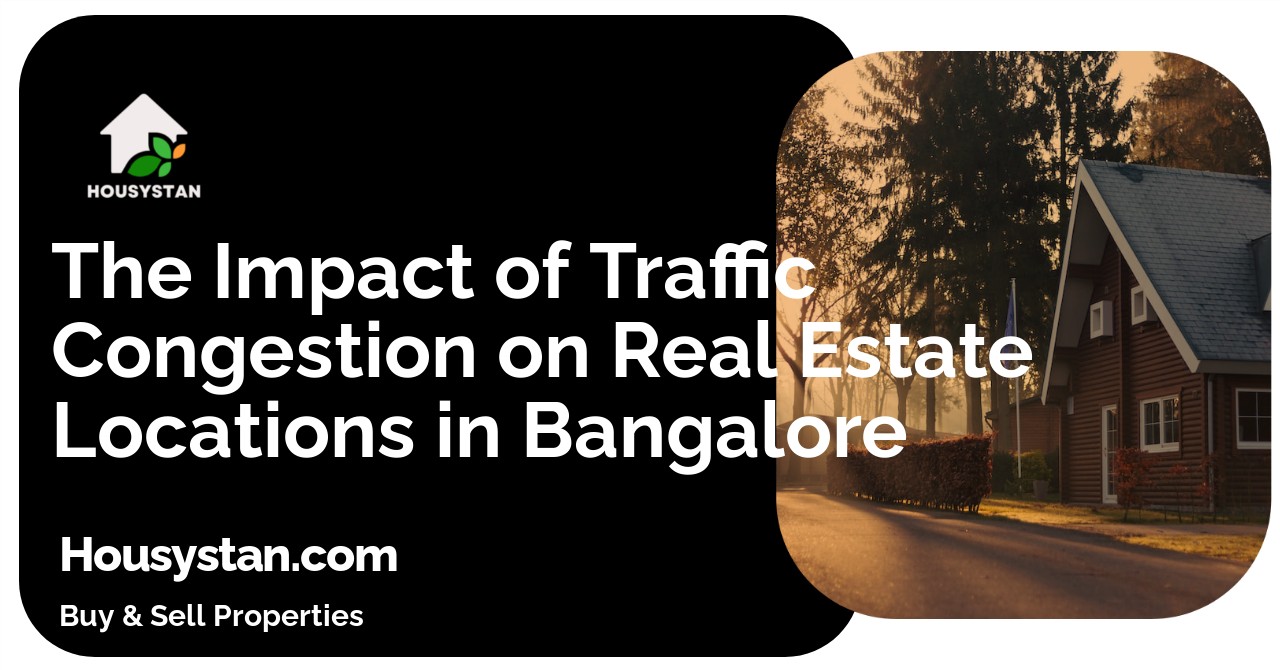The Impact of Traffic Congestion on Real Estate Locations in Bangalore
Read latest blogs and articles from Housystan

The Information mentioned here was last updated on:
14/12/2025The Impact of Traffic Congestion on Real Estate Locations in Bangalore
Bangalore, often touted as the Silicon Valley of India, is a bustling metropolitan known for its vibrant tech industry and cosmopolitan culture. However, with this rapid urban growth comes a challenge that many residents are all too familiar with: traffic congestion. The gridlock on Bangalore's roads doesn't just test the patience of commuters; it significantly influences the real estate landscape of the city.
Understanding Bangalore’s Traffic Woes
- Verified Tenants/Buyers
- Unlimited Property Listing
- Zero subscription/charges fee
Bangalore's traffic congestion is a result of several factors. The city's infrastructure has struggled to keep pace with its swift population growth and increasing number of vehicles. Narrow roads, insufficient public transportation options, and the ever-expanding urban sprawl add layers of complexity to the problem. This situation is not unique to Bangalore, but the intensity and frequency of traffic jams make it a remarkable case for examining how it impacts real estate.
The Proximity Premium
In real estate, the mantra often heard is "location, location, location." In Bangalore, the value of a location is heavily influenced by its accessibility. Areas that offer easy access to major business districts and are close to public transportation hubs naturally demand a "proximity premium." For instance, neighborhoods like Indiranagar, Koramangala, and Whitefield, which connect well to IT hubs, have seen increased demand and, consequently, higher property prices. Residents are willing to pay a premium to reduce commute times, preserving precious hours that would otherwise be lost in gridlock.
Shift in Residential Preferences
Traffic congestion has led to a noticeable shift in the residential preferences of Bangaloreans. Many young professionals are opting to live closer to their workplaces, even if this means compromising on space. This trend is driving a surge in demand for compact apartments and co-living spaces within or near tech parks. As a result, real estate developers are responding by creating innovative living solutions that cater to these preferences, blending convenience with modern urban living.
The Rise of Integrated Townships
As a response to traffic congestion, integrated townships have gained popularity in Bangalore. These large-scale residential complexes offer a holistic living experience with amenities such as schools, shopping centers, and healthcare facilities within the premises. The idea is to minimize the need for long commutes by providing everything a family might need in one place. Areas like Sarjapur and Devanahalli have seen the emergence of such townships, catering to the growing middle class and expatriate communities in the city.
The Influence on Commercial Real Estate
Traffic congestion doesn't just impact residential real estate; it plays a significant role in shaping the commercial property market as well. Business owners often consider traffic patterns when selecting office locations, prioritizing accessibility for employees and clients. The rise of IT parks and tech corridors along the Outer Ring Road and Electronic City demonstrates this trend, as these areas are strategically situated to alleviate time lost in traffic. Easy access to major highways, public transport, and well-planned road networks are crucial factors that businesses evaluate.
Connectivity and Infrastructure Projects
Efforts to improve Bangalore’s traffic conditions have led to numerous infrastructure initiatives, such as the expansion of the Namma Metro and the development of flyovers and underpasses. These projects are intended to enhance connectivity across the city, and they have a direct impact on real estate values in their vicinity. Properties near new metro lines or improved road networks often see an appreciation in value due to anticipated ease of access. As such investments in infrastructure continue, they shape both current and future real estate trends.
Telecommuting and Its Impact
The increasing acceptance of remote work, particularly post-pandemic, has brought a new dimension to Bangalore's real estate dynamics. With more companies allowing flexible work arrangements, employees are no longer bound to live near their workplaces. This change has led to the growth of real estate in suburban areas where living costs are lower, and quality of life is perceived to be better. Areas once considered too remote due to traffic constraints are now becoming attractive options for families seeking more space and greenery.
Environmental Concerns and Real Estate
Traffic congestion in Bangalore contributes significantly to pollution and environmental degradation. As awareness grows and environmental sustainability becomes a priority, real estate developers are increasingly focusing on eco-friendly projects. Green buildings, which feature energy-efficient designs and sustainable materials, are attracting attention. Properties offering eco-friendly living options appeal to environmentally conscious buyers, which can drive demand and impact real estate valuations.
The Role of Government Policies
Government policies and regulations play a crucial role in shaping the real estate landscape in response to traffic congestion. Initiatives aimed at improving public transportation, managing urban sprawl, and promoting sustainable urban development are critical. The introduction of congestion charges, car-pooling incentives, and stricter vehicular emission norms are among the measures that can indirectly influence real estate trends by improving overall quality of life in the city.
Conclusion
As Bangalore continues to evolve, the interplay between traffic congestion and real estate development remains a key focal point. The city's progress hinges on strategic planning that addresses traffic challenges while nurturing sustainable growth. By understanding the intricate relationship between transportation and real estate, stakeholders can make informed decisions that will shape the future of this dynamic metropolis. While there is no singular solution, a combination of improved infrastructure, government policy, and innovative urban planning can pave the way for a more commuter-friendly and livable Bangalore.